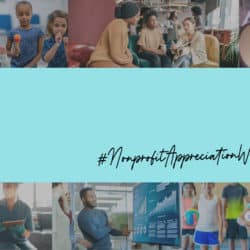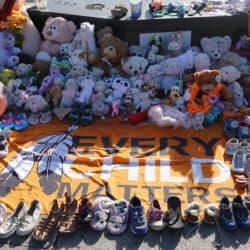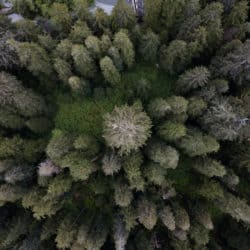Choosing hope: Acts of reconciliation
“Hope is the thing with feathers that perches in the soul,” wrote Emily Dickinson. But for the Mi’kmaq of Atlantic Canada, hope perches in the branches of a forest where hemlock, maple, and pine stand as gestures of reconciliation.
Windhorse Farm was “sustainably stewarded by settlers for nearly two centuries,” but in late November, Ulnooweg Development Group, an Indigenous entrepreneurship and community development organization, announced its transfer to Mi’kmaq stewardship. Under the branch of the Ulnooweg Education Centre, Windhorse’s 90 hectares of forest, organic permaculture gardens, conference lodge, off-grid cabins, and trails will become a place of healing, learning, conservation, and “a space to host the world.”
“There’s so much to discuss about reconciliation – how do governments do it, how do organizations do it,” says Chris Googoo, COO of Ulnooweg. “It seems to be harder when people ask how do individuals do it. This is a great example of how reconciliation can actually occur.”
While lawyers hammer out the details of Windhorse’s transfer, Googoo stresses that the return of lands where his ancestors have lived for more than 10,000 years isn’t about ownership. “The land is the land,” he says. “We can’t own it, and we don’t want to.” The trees, lake, river, brooks, birds, and animals that call Windhorse home are family. “We can’t own our siblings,” Googoo says. The Mi’kmaq view human beings as children of Mother Earth, a belief at the core of a worldview based on interconnectedness.
This view gives rise to netukulimk – another word for sustainability, according to the Unama’ki Institute of Natural Resources, which defines the term as a recognition of our interdependence with the natural world, that we can take the gift “the creator” has given us “without compromising the ecological integrity of the area.” Kerry Prosper, a Mi’kmaw Elder, explained the concept to the Halifax Examiner: “When you’re Indigenous and you live on a geographic piece of land for thousands of years, you become spiritually, genetically, physically, traditionally a part of everything.”
Googoo sees Windhorse as a safe and consoling space. Elders have always taught about the healing powers of the forest, he says. “Go out there and let it comfort you, let it console you.” A forest provides a place for reconciliation to occur, he says, but with reconciliation comes the trauma of past histories, such as residential schools.
At Windhorse, in a forest that’s been “loved and sustained” and where many centuries-old trees still stand, Googoo feels positive energy flowing through the plants and animals. Some people feel “overwhelmed” by such energy, he says, calling it spiritual or magical. “But I don’t want to mystify it. It’s no different than somebody putting a hand on your shoulder to console you.”
In essence, “we’re trying to create hope here,” Googoo says – about the climate crisis and all the “existential threats that we all share at the same time.” There’s an increased awareness, at least in some circles, he says, that Indigenous knowledge needs to be brought into these discussions to save our planet.
These circles are growing larger. In light of the latest Intergovernmental Panel on Climate Change report – dubbed “code red for humanity” by the United Nations – numerous reports point to Indigenous communities for their “critical” role in reducing global emissions and promoting conservation. Indigenous-led networks such as Conservation through Reconciliation and Land Needs Guardians have become beacons of hope internationally.
Elin Kelsey, the author of Hope Matters: Why Changing the Way We Think Is Critical to Solving the Environmental Crisis, says hopefulness is an antidote to “climate doom” – a feeling of helplessness that stems from a constant doom-and-gloom narrative that’s as effective as climate denial in creating inaction. To have hope is to be informed, she says in an interview with CNBC, adding, “It’s a political choice to be hopeful.”
“I think people, especially after two years of COVID, they have a thirst for hope, for stories that are actually about a different way of how people treat each other,” says Googoo. Even if the philanthropic sector doesn’t always operate according to principles like interconnectedness, he says, the concept is worth exploring. “The status quo doesn’t seem to work right now.”
Measuring hope: A national survey of hopefulness
Hope springs eternal, even as we enter Year Three of a global pandemic, at least according to the results of a Mental Health Research Canada (MHRC) survey conducted in partnership with Imagine Canada. The Hopefulness Survey shows that 61% of Canadians are feeling more hopeful this year as they enter the holiday season. Eighty percent credit the ability to see friends and family in person for having the biggest impact on their hopefulness, while 50% say charitable giving and 45% say volunteering are keeping the flames of hope stoked.
The survey polled 4,108 Canadians between October 22 and November 3, and while the findings pre-date the arrival of the Omicron variant, Akela Peoples, CEO of MHRC, predicts the results won’t vary much for upcoming surveys. Since MHRC began collecting data at the beginning the pandemic, “many of the elements that we’ve been looking into have stayed remarkably similar,” she says. “Despite lockdowns, despite vaccinations, despite all the variables that have come and gone, the resiliency of Canadians has been quite impressive.”
The non-profit sector, while still struggling, has shown similar resiliency. According to Statistics Canada’s Canadian Survey on Business Conditions, Third Quarter 2021, nearly 90% of 1,060 non-profits sampled across Canada reported feeling positive about the year ahead.
But Peoples offers some cautions. “Certainly, the longer a pandemic goes on, the more risk we have of losing hope,” she says, adding that some key groups, such as younger people, healthcare workers, mothers, and those who identify as LGBTQ2I, already “indicate a lower ability to be resilient to challenges, which would lower their ability to be hopeful.”
The MHRC’s series of polls on “Mental Health in Crisis: How COVID-19 Is Impacting Canadians” provides further insights. The ninth poll, conducted in tandem with the Hopefulness Survey, shows that while anxiety levels and suicidal ideation are no longer increasing, they remain high, and serious levels of depression remain constant. Nearly 30% of front-line workers report high levels of depression. More than a quarter of younger Canadians have thought about suicide, and 7% have planned an attempt in the past year.
In The Impact of COVID-19 on the Mental Health of Canadian Children and Youth, the authors point out that Canada struggled with a mental health crisis long before the pandemic. According to a 2020 UNICEF report, Canada ranked 35th out of 38 countries on teen suicide rates, highlighting “our systemic failure.”
Throughout the pandemic, MHRC has compiled an extensive data set, says Peoples, and while the need to examine the negative elements of the pandemic is important, they were “keen to explore” hopefulness as one of the “positive powerful forces” also in existence.
A recent article in The Atlantic says that as the pandemic has “slowly transformed from a temporary inconvenience into a new way of life,” hope is more important than ever. One study touts hope as a “far more potent force” than optimism when it comes to improving well-being; another concludes that “lacking it is disastrous.”
Research informs decision-making, says Peoples, and evidence-informed data about the state of Canadians’ mental health can lead to solutions. Awareness that a young person’s mental health can benefit from participating in charitable activities, for example, or that seniors can feel less lonely by volunteering, may change behaviours. More than 10,000 apps claim to support mental health, Peoples says, but “very, very few of those apps are evidence-informed.”
“If there’s anything good to come out of this pandemic, we spotlighted mental health,” Peoples says, “and mental health for everyone – not just mental health for people who have mental health challenges.” We can all relate, she says, “in a way that we never could before.”
She adds her own note of hope: “I believe there are going to be some very positive changes in our society and our workplaces that are going to emerge permanently. From this very negative crisis we’ve been going through, at least there’s that.”
Building hope: Breathing new life into non-profit sector workforces
As a pandemic-battered non-profit sector tries to rebuild, Imagine Canada has released a set of tools this holiday season – HR Intervals – to make that task a little easier, and to build upon concepts such as decent work, wellness, and equity.
“Attracting and retaining talent is a challenge in our sector, a reality that the pandemic has only amplified. The health crisis of the past 20 months has also shifted how organizations operate and introduced new challenges and opportunities related to work culture,” said Bruce MacDonald, president and CEO of Imagine Canada, in a press release.
Catalyst for Change: A Roadmap to a Stronger Charitable Sector, a Special Senate Committee on the Charitable Sector report, warned that the sector faces a “significant challenge” in recruiting and retaining staff of all ages for a host of reasons, including burnout, poor compensation, inadequate benefits packages, and the lack of retirement plans.
It’s been three years since the HR Council for the Nonprofit Sector services were retired, MacDonald notes, leaving sector leaders without free resources to “better understand, address, and guide people management in their organizations.” With the support of eight launch partners, including CIBC, Community Foundations of Canada, and The Counselling Foundation of Canada, HR Intervals aims “to fill that gap” with an “updated and reimagined set of resources,” says MacDonald. New resources will be added regularly.
The content includes reference material on job descriptions, HR strategic planning, workplace wellness, and equity and decent work.
The initiative acknowledges, among other things, that decent work is “a critical pathway to gender equity, racial justice, and reconciliation in the nonprofit sector.” Numerous reports, open letters, and opinion pieces have documented a work culture traditionally steeped in discrimination and inequity.
“Women’s economic well-being must be prioritized in recovery plans,” note the authors of Resetting Normal: Women, Decent Work and Canada’s Fractured Care Economy. “A post-pandemic economy and post-pandemic workplaces shaped without women’s participation can only deepen structural barriers to equality.”
HR Intervals provides links to the Ontario Nonprofit Network’s case studies about decent work in action, and also 121 Decent Work Ideas, including Wagemark, an international wage standard, and The National Standard for Psychological Health and Safety in the Workplace. “At this moment, decent work is more important than ever for our sector,” they write, as we need the best workforce possible to “carry out our community-oriented missions and solve the most complex social problems of our time.”
The accompanying image, by Zachary Mollica, is of “Mother Maple.” Estimated to be hundreds of years old, the tree stands in a clearing on the Windhorse Farm property. This image is part of a 60-photo collection, captured on a walk in the forest at Windhorse Farm. The images were processed through photogrammetry to create a rich three-dimensional model of Mother Maple. Still and moving animations produced from this model present new ways to engage with and observe this notable tree.


